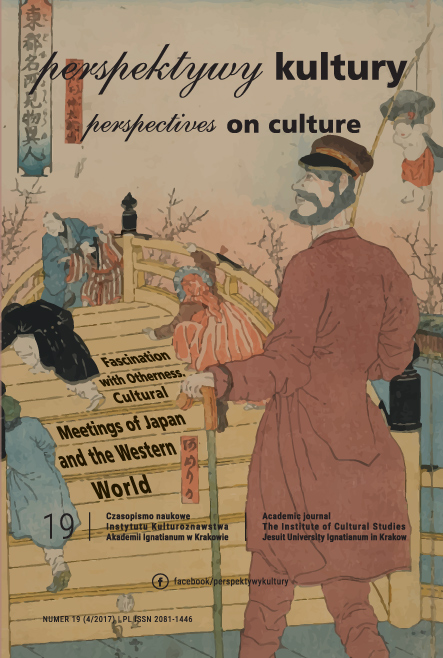Sztuka dwóch Wschodów: Wielki Sfinks na drzeworytach Hiroshi Yoshidy
Abstrakt
Hiroshi Yoshida (1876-1950), japoński malarz i drzeworytnik, znany był szczególnie ze swoich doskonałych kompozycji krajobrazowych. Two- rzący w europejskiej technice malarstwa olejnego artysta podróżował po świecie i eksperymentował także z wykonanymi w tradycyjnym stylu drzeworytami, przedstawiającymi nie-japońskie pejzaże i obiekty archi- tektoniczne (m.in. Stany Zjednoczone, Indie, Alpy szwajcarskie itd.). Kultywował tradycję klasycznej konwencji ukiyo-e, w XX wieku odno- wionej jako shin-hanga. Artykuł przypomina jedno z tych niezwykłych dzieł: nocny i dzienny widok Wielkiego Sfinksa egipskiego. Drzeworyt jest bardzo precyzyjny, a dzięki kilku detalom można określić datę po- wstania prototypu, ponieważ odwzorowuje ważny etap prac konserwa- torskich prowadzonych przy sławnym posągu. Dygresją artykułu są tak- że uwagi o interesujących wątkach japońsko-egipskich w XIX wieku oraz współczesnych pracach japońskich egiptologów.
Bibliografia
ALLEN Laura W. 2002. A Japanese Legacy: Four Generations of Yoshida Family Artists (Art Media Resources). Minneapolis: Minneapolis Institute of Arts.
BENNETT Terry. 1996. Early Japanese Images. Rutland: Charles Tuttle Comp.
BLAIR Dorothy. 1951. „Hiroshi Yoshida, 1876-1950”. Artibus Asiae, Vol. 14, No. 1/2, pp. 163-168.
BROWN Kendall H., GOODALL-CRISTANTE Hollis. 1996. Shin-Hanga: New Prints in Modern Japan, Los Angeles: County Museum of Art.
EASTON Matthew. 1992. „Scientists, Scholars and the Sphinx: A report from the Sphinx Conference”. American Research Center in Egypt Newsletter (Princeton) 156/157: 20-21.
LAL GAURI K., HOLDREN G.C. 1981. „Deterioration of the Stone of the Sphinx”. American Research Center in Egypt, Newsletter 114: 35-47.
LAL GAURI K. 1984. „Geological Study of the Sphinx”. American Research Center in Egypt, Newsletter 127: 19-27.
GNAEDINGER John P. 2006. Proposed Hypothesis, Testing and Documen- tation, and Actions to be Taken for the Conservation of the Sphinx, In The World of Ancient Egypt. Essays in Honor of Ahmed Abd el-Qadar el-Sawi, S. Abd el-Fatah, K. Daoud (eds.): 113-120. Cairo: Supreme Coun- cil of Antiquities.
HASSAN, Selim. 1949. The Sphinx. Its History in the Light of Recent Excava- tions, Cairo: Government Press.
HAWASS Zahi. 1992. History of the Sphinx Conservation, In Book of Pro- ceedings. The First International Symposium on the Great Sphinx: 165-214. Cairo: Egyptian Antiquities Organization Press.
HAWASS Zahi. 1998. The Secrets of the Sphinx. Restoration Past and Present. Cairo: The American University in Cairo Press.
KEYES Roger S. 1984. Japanese Woodblock Prints: A Catalogue of the Mary A. Ainsworth Collection. Oberlin, Ohio: Allen Memorial Art Museum, Oberlin College, Bloomington, Ind.
ROBINSON H.E., YASUNAGA Koichi. 1991. The Complete Woodblock Prints of Yoshida Hiroshi. North Clarendon VT: Tuttle Publishing.
MACLEAN Arthur J., BLAIR Dorothy. 1929. „Two Modern Japanese Print-Makers”. The American Magazine of Art, Vol. 20, No. 2 (February), pp. 98-101.
MERRITT Helen. 1990. Modern Japanese Woodblock Prints: The Early Years. Honolulu: University of Hawaii Press.
MERRITT Helen, YAMADA Nanako. 1995. Guide to Modern Japanese Wood- block Prints: 1900-1975, Honolulu: University of Hawaii Press.
MICHENER James A. 1959. Japanese Prints – From the Early Masters to the Modern. Tōkyō: Rutland.
NEWLAND Amy Reigle. 2005. Hotei Encyclopedia of Japanese Woodblock Prints. Amsterdam: Hotei.
OGURA Tadao. 1996. The Complete Woodblock Prints of Yoshida Hiroshi, Tōkyō: Abe Shuppan [Japanese text].
OSMAN Colin. 1990. „Antonio Beato: Photographs of the Nile”. History of Photography, vol. 14, no. 2 (April-June).
POLLARD Moyra Clare, LANDRUS Mallica Kumbera, LAHIRI Avijit. 2015. Yoshida Hiroshi: A Japanese Artist in India. Woodblock Prints from the Lahiri Collection. 9 June – 13 September 2015, the Ashmolean Museum of Art and Archaeology. Oxford: University Press.
SALTER Rebecca. 2002. Japanese Woodblock Printing. Honolulu: University of Hawaii Press.
SHARF Frederic A. 1994. Takejiro Hasegawa: Meiji Japan’s Preeminent Pub- lisher of Wood-Block-Illustrated Crepe-Paper Books. Salem: Peabody Essex Museum.
SKIBBE Eugene M. 1993. „The American Travels of Yoshida Hiroshi”. An- don 43 (January): 59-74.
SMITH Lawrence. 1994. Modern Japanese Prints 1912-1989. New York-Lon- don-Paris: Cross River Press.
STATLER Oliver. 1956. Modern Japanese Prints – An Art Reborn. Rutland: Tuttle Publishing.
STEWART Basil. 1979. A Guide to Japanese Prints and Their Subject Matter. New York: Dover Publications Inc.
VOLLMER April. 2012. „Mokuhanga International”. Art in Print, Vol. 2, No. 2 (July-August), pp. 4-13.
WAHBY Wafeek S. 2005. Restoring and Preserving Egypt’s Sphinx: the Poly- mers Option, 10th Canadian Masonry Symposium, Banff, Alberta, June 8-12, 2005 (online: http://www.canadamasonrydesigncentre.com/research/ restoring-and-preserving-egypts-sphinx-the-polymers-option/)
YOSHIDA Hiroshi. 1939. Japanese Woodblock Printing , comprehensive guide to the craft of woodblock printing written by Hiroshi Yoshida. Tōkyō-Osaka: Sanseido Company, Ltd.
YOSHIDA Hiroshi. 1987. The Complete Woodblock Prints of Yoshida Hiroshi. Tōkyō: Abe Publishing Co.
ZANNIER Italo. 1986. Verso oriente: Fotografie di Antonio e Felice Beato. Flo- rence: Alinari.
ZIVIE-COCHE Christiane. 1984. Sphinx, In Lexikon der Ägyptolo- gie, W. Helck, W. Westendorf (eds.), Vol. V: 1139-1147. Wiesbaden: Harrassowitz.
ZIVIE-COCHE Christiane. 2002. Sphinx: History of a Monument, Ithaca-London: Cornell University Press.
Copyright (c) 2017 Akademia Ignatianum w Krakowie

Utwór dostępny jest na licencji Creative Commons Uznanie autorstwa – Bez utworów zależnych 4.0 Międzynarodowe.
Autor, zgłaszając swój artykuł, wyraża zgodę na korzystanie przez Wydawnictwo Uniwersystet Ignatianum z utworu na następujących polach eksploatacji:
- utrwalania utworu w formie papierowej, a także na nośniku cyfrowym lub magnetycznym;
- zwielokrotnienia utworu dowolną techniką, bez ograniczenia ilości wydań i liczby egzemplarzy;
- rozpowszechniania utworu i jego zwielokrotnionych egzemplarzy na jakimkolwiek nośniku, w tym wprowadzenia do obrotu, sprzedaży, użyczenia, najmu;
- wprowadzenia utworu do pamięci komputera;
- rozpowszechniania utworu w sieciach informatycznych, w tym w sieci Internet;
- publicznego wykonania, wystawienia, wyświetlenia, odtworzenia oraz nadawania i reemitowania, a także publicznego udostępniania utworu w taki sposób, aby każdy mógł mieć do niego dostęp w miejscu i czasie przez siebie wybranym.
Wydawca zobowiązuje się szanować osobiste prawa autorskie do utworu.





